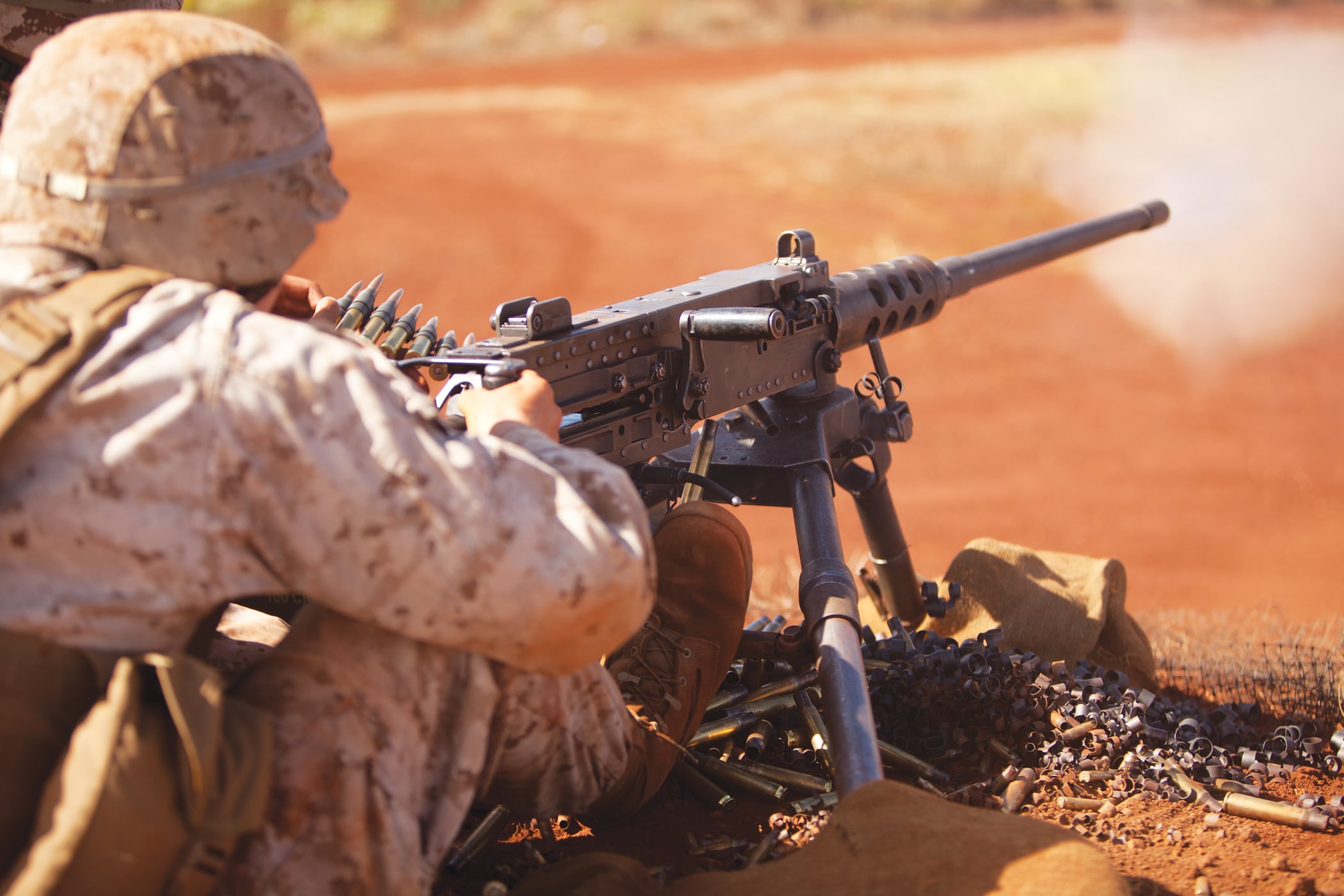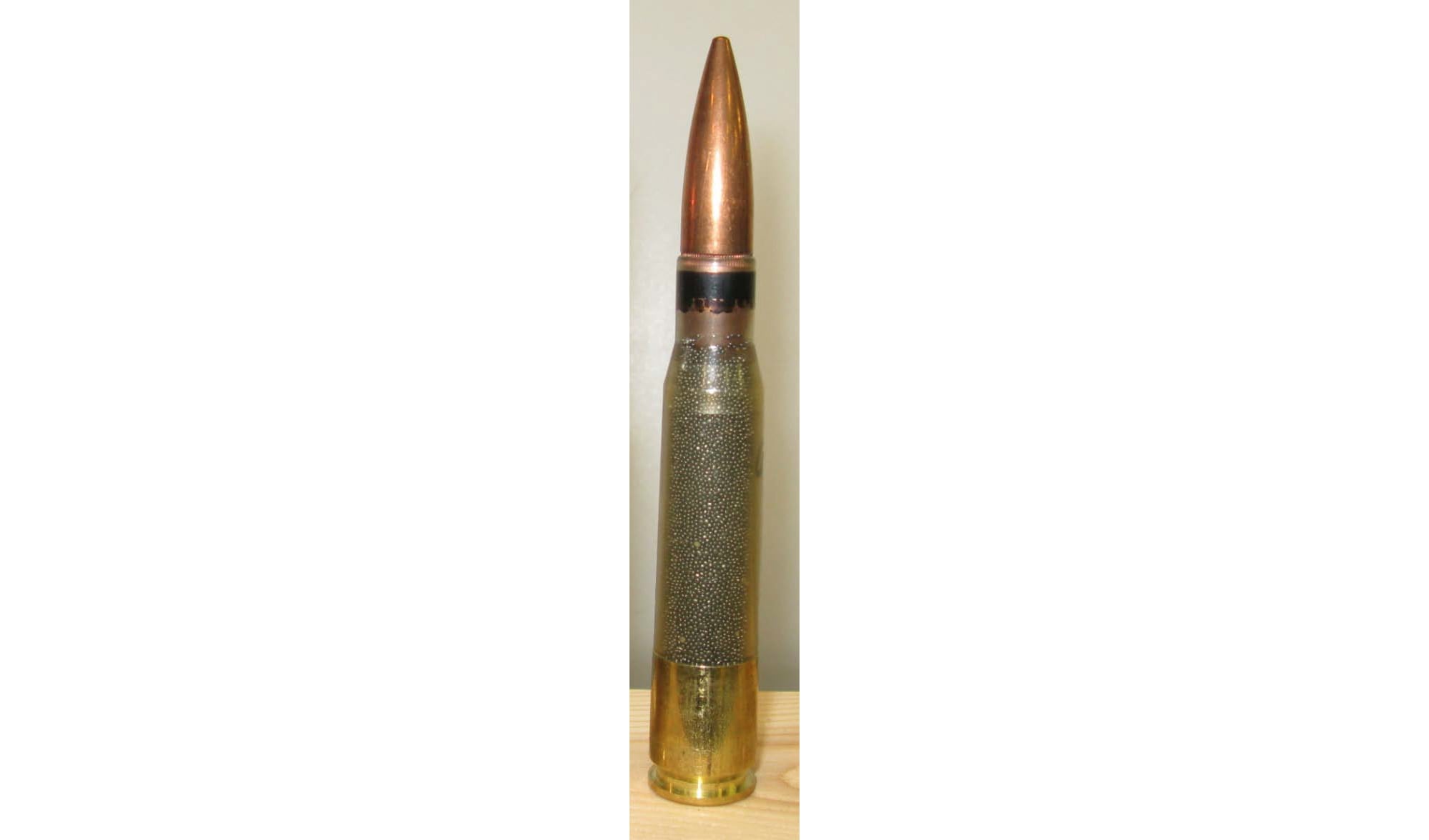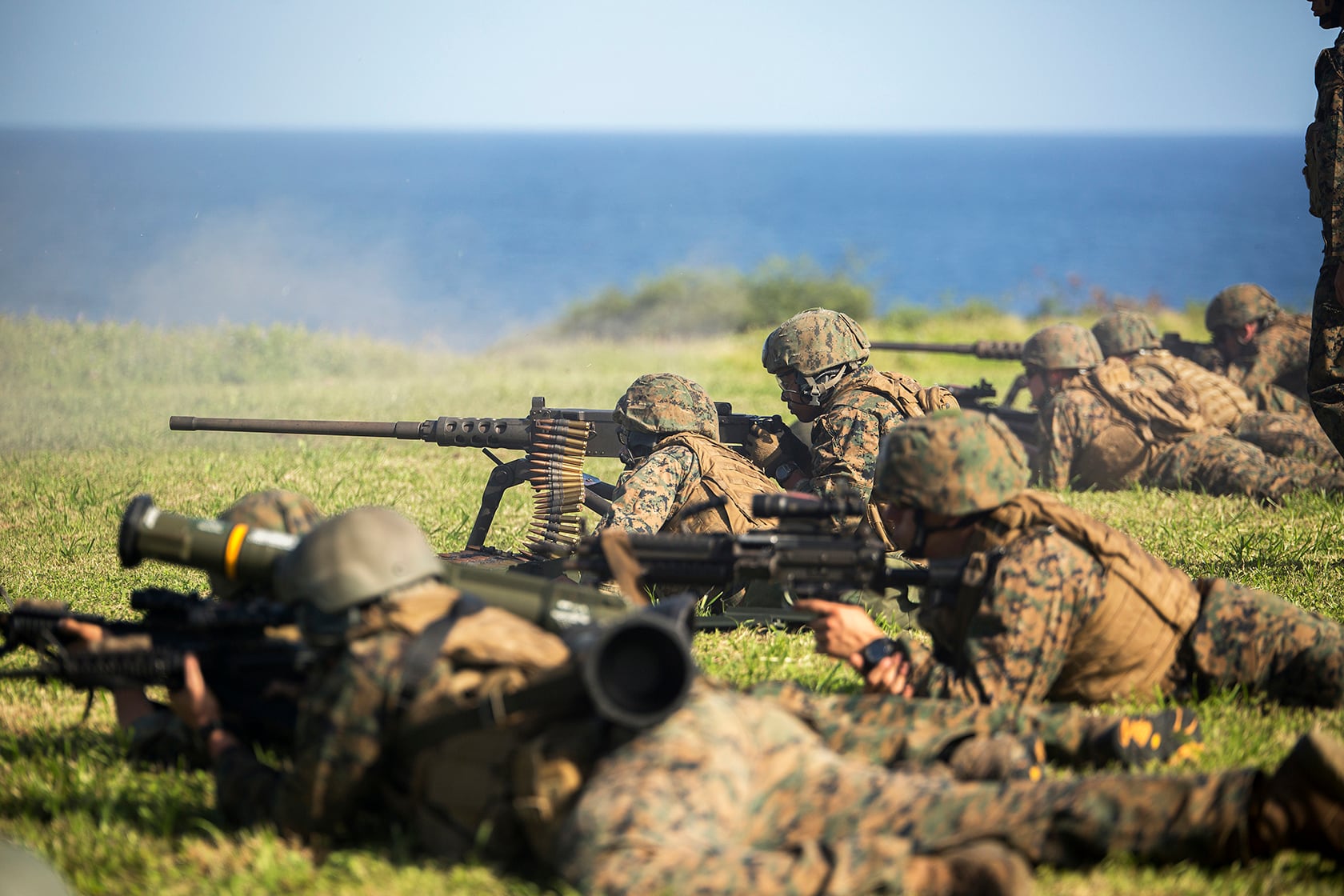MARINE CORPS BASE QUANTICO arine Corps Base Quantico, Va. — Marines could soon be carrying everything from custom-painted rifles and suppressors to lightweight tripods and plastic-cased ammunition as the Corps rolls out a massive small-arms modernization plan officials hope will give the service an edge on the battlefield for decades to come.Quantico Marine officials recently unveiled a A comprehensive small-arms modernization plan that could eventually alter nearly every piece of weaponry Marines carry, from painted rifles and optics, to light-weight .50-caliber ammunition and suppressors for every member of Marine in a rifle squad, has been unveiled by Marine officials here.
Formally called tThe Small Arms Modernization Strategy, it is a rolling plan that will focus on updating modernization of current weapons in the short-term and developing the development of futuristic systems that could start hitting the fleet in the mid-2020s, according to senior officials at Combat Development and Integration Command’s Fires and Maneuver Integration Division in Virginia. That has significant implications for all Marines, from door-kicking squad leaders to logisticians running convoy operations.
"We are always looking to ensure our Marines have the best weapons in terms of lethality, range and accuracy," Chris Woodburn, a retired colonel who now serves as the deputy Maneuver Branch head for the Fires and Maneuver Integration Ddivision, told Marine Corps Times in an exclusive interview that detailed the new comprehensive strategy.
All plans, he said, are driven by needs expressed by commanders and Marines in the field. To meet those needs, CD&I is working with multiple organizations, including U.S. Special Operations Command and the Joint Services Small Arms Program Office, which is the Defense Department’s Army-led small-arms advocate, which includes members of with representation from every service and U.S. Special Operations Command. A similar partnership in the past resulted in the development of SOCOM has partnered with the Marine Corps to develop which has been a past partner in the development of the now widely fielded 5.56mm Special Operations Science and Technology "barrier blind" cartridge.
Driving each initiative, Woodburn said the Marine Corps isn't just focused on , is not just lethality, range and accuracy, but also weight and mobility. The weight carried by Marines has ballooned exponentially over the years, increasing injuries and decreasing maneuverability.
As the Corps looks toward future crisis response missions that leave small teams of Marines deployed without a massive logistics support chain, the service is looking at ways to keep teams sustained without getting bogged down with the weight of ammunition and batteries. That has driven which is driving efforts behind to streamline kit and meet the demands of new concepts of operations like Expeditionary Force 21 which emphasizes the need for Marines to travel light and fast as they react to far-flung crisis on a moment’s notice.
"We want improved capability with no impact on mobility, with improved mobility as a goal," Woodburn said.
Here are some of the a few major highlights as the Marine Corps looks to upgrade its small-arms arsenal. from the comprehensive Small Arms Modernization Strategy.
Making Marines stealthy
The Corps is considering allowing A top priority is holistic signature management, which could lead to camouflage painted rifles for every Marine and suppressors for every rifle squads, Woodburn said. It's part of an effort to help Marines blend into their surroundings and communicate better. The moves That could also give give every Marine an "operator" look, although both initiatives are just now being researched.
Driving the effort is the idea to bring rifles in line with the rest of Marine gear. While countless millions of dollars have been spent to developing and fielding Marine Pattern digital camouflage in desert and woodland color schemes, arguably the Defense Department’s best camouflage – Marine Pattern in desert and woodland – Marines still carry black rifles with a distinctly mechanical shape. While Marine’s MARPAT uniforms and coyote brown gear blends, the color and outline of rifles stands out against any natural environment. A Marine may be well concealed, but the rifle he carries could give him away.
A near-term fix could give commanders the authority to allow authorize Marines to paint their rifles at a commander’s discretion to match the environment to which they're deploying they deploy to, Woodburn said. It is something many civilian hunters and members of elite units like Marine Corps Forces Special Operations Command already do. The Army has also authorized the move since 2010, when the service recognized Recognizing the need for better concealment in Afghanistan, regular "big Army" soldiers were also authorized in 2010 to paint their rifles on deployment.
Some troops and hunters achieve the desired effect with commercial spray paints, while taking care to properly mask optics and other sensitive parts of a rifle. However, Woodburn said the Marine Corps is working with the Office of Naval Research in Dahlgren, Virginia, to develop something that can withstand high temperatures and possibly provide other benefits, like concealment in the non-visible spectrum. That would match parallel efforts already underway to develop camouflage uniforms that can be concealed across the electromagnetic spectrum, preventing the enemy from spotting Marines through optics that pick up on wavelengths invisible to the naked eye. conceal against observation with optical devices that pick up on heat, infrared or even short-wave infrared.
It's not immediately clear whether individual would be critical to develop a standard, approved process for applying and removing paint, too, so weapons and accessories aren’t damaged. Whether Marines in the field, or unit armorers would handle the painting of rifles. also has to be determined. Marine officials are also examining the right method, so weapons and accessories aren't damaged in the process of applying or removing paint.
But even if a rifle is painted, its loud crack immediately compromises a Marine's location. For that, the service is now conducting a two-year study to determine if issuing suppressors to all rifle squads is feasible.
Suppressors work by slowing expanding gasses, which, unrestricted, leave the muzzle at supersonic speeds. They Suppressors make it more difficult to determine a shooter's exact location.
More importantly though, Woodburn said, is that they but more importantly improve command and control within an infantry unit. , Woodburn said. That is especially important particularly the case indoors, where the cacophony of a squad clearing rooms can be disorienting and make it nearly impossible to use verbal communications.
There are some drawbacks though. Suppressors require Potential drawbacks associated with suppressors include additional cleaning and heat up during sustained shooting. They also increase and increased back pressure, which can cause extra wear or malfunctions, particularly on short-barreled rifles. In some cases, that requires installation of an adjustable gas block with a switch. The switch can be flipped, depending on whether or not a suppressor is in use, to change the amount of gas siphoned from the barrel and down the weapon’s gas tube to operate the bolt. That would, however, require the Corps to purchase the new parts and have armorers install them. procurement of a new part and installation by armorers.
In order to determine whether to issue suppressors to rifle squads, To determine the feasibility of widely using suppressors and any associated drawbacks, the Marine Corps is launching beginning a two-year study in which it'll partnering with special operations and NATO units that already use them. widely issued them including Special Operations Command and NATO allies.
M2 machine guns
The Marine Corps' ground-mounted M2 Browning machine gun, a workhorse since World War II, is getting a conversion kit to take it far into the 21st century. The kit will make them M2A1s, an improved version already used by the Army that includes quick-change barrels with fixed headspace and timing.

The Marine Corps' ground-mounted M2 Browning machine gun is getting a conversion kit that will turn them into M2A1s, an improved version already used by the Army. Here, a machine gunner with 1st Battalion, 3rd Marines, shoots during crew-served weapons training in 2013.
Photo Credit: Lance Cpl. Suzanna Knotts/Marine Corps
For now, Marines will still have to use a gauge to set the headspace and timing whenever they change a barrel. But by late fiscal 2016, upgraded M2A1s will hit the fleet. Full fielding to replace every ground-mounted M2 will be completed by late 2018 FY19.
At best, improper headspace and timing causes weapons malfunctions, Woodburn said. At worst, it is a safety issue as it can result in an explosive failure that can injure an operator or nearby Marines.
The conversion kit will also include a new flash hider that reduces muzzle flash by 50 percent. That will be a welcome relief, particularly for gunners during nighttime engagements when blinding muzzle flash can make it difficult to see targets through night vision goggles.

Marine Corps officials are considering whether to move to polymer casings, which are significantly lighter and would allow Marines in the field to carry more ammunition.
Photo Credit: NAVSEA
Polymer ammunition
Long-time research efforts into polymer ammunition could also soon yield new lightweight ammunition for the M2. The move could allow Marines to carry with 25 percent weight savings. That translates to carrying 40 percent more ammunition at the same weight they carry now.
In recent months, the The Marine Corps has completed testing evaluation of polymer-cased ammunition that which uses extremely durable plastics to form the cartridge’s case in place of rather than traditional brass. Testing of the next-generation cartridges was completed this quarter.
Marine leaders are now reviewing the test results in order to determine whether the service will Results are now under consideration ed with a final decision to purchase the new to procure polymer-cased ammunition hinging on approval by leaders.
Lightweight tripods
Like polymer-cased ammunition, a new medium machine gun tripod is focused on weight savings for the service's crew-served weapons as developers work to improve capability without compromising mobility.
The lightweight tripod, mostly used for use with the 7.62mm M240, offers about 19 percent weight savings. That which trims nearly 4 pounds off the legacy tripod, which weighs was about 20 pounds. It will hit the fleet in late fiscal 2016.
The Army recently adopted a version of a its own lightweight tripod, Woodburn said, but the Marine Corps opted to develop its own with the exact functionality of current tripods. The Army developed one with adjusting levers rather than traversing and elevation mechanisms that are twisted.
New pistols
The Marine Corps is closely following the Army's efforts to develop a next-generation pistol. But since because the Marine Corps issued M4 carbines to many who would be in a position to traditionally carry a pistol, like officers, the service is not driven by the same sense of urgency as the Army, which is now pursuing development of the Modular Handgun System. The MHS will ould replace the 9mm Berretta M9, and could provide a heavier hitting round.
The Marine Corps is participating in the program to have input on source selection, Woodburn said, with the likelihood that whatever the Army eventually adopts will be adopted by all services.
The Marine Corps' current inventory of pistols, however, should suffice through the early 2020s, based on their planned life-cycle, he said.
M4 and M16 upgrades
A significant short-term push by the Small Arms Modernization Strategy seeks to keep the service's M4 and M16 rifles running reliably into the future with incremental upgrades until a next-generation rifle is built from the ground up.
The first piece of the strategy offers a huge jump in capability for the infantry at no additional cost, according to officials. A recommendation — still pending awaiting final approval by the commandant — calls for the infantry to switch from the M16A4 rifle exclusively to the M4 carbine. The service already has enough in its inventory to accomplish the transition, meaning armories simply need to issue them if given the go ahead.
The recommendation was driven by the M4’s reduced weight and size, with an overall length nearly 10 inches shorter than the M16. That is especially an advantage for those who operate in vehicles, on ships or in urban settings. and on patrol through tight quarters in rural compounds, like those seen in Afghanistan, or urban allies and buildings, like those seen in Iraq.
Support Marines will still use the M16, but some will have access to a new adjustable but enjoy a recent upgrade its to the stock. The limited number provided to each unit in 2014 can be issued to Many will still have a traditional stock, but in 2014 an initial quantity of adjustable stocks, like those on the M4, were issued to units. That is particularly useful for smaller Marines who may find it have complained about the rifle’s length of pull – the distance from the end of the stock to the trigger – saying it is difficult to comfortably reach the trigger on an M16 when wearing body armor.
The adjustable stocks were also added as a standard authorized accessory, meaning units needing more can use operations and maintenance funds to purchase them at will.
Perhaps most anticipated, but least certain, are an array of potential improvements based on commonly available after-market accessories widely used by competitive civilian shooters. Those could include free-floating barrels, matched-grade or full-auto trigger groups that would provide consistent trigger pull, and flash hiders or compensators that manage recoil for faster follow-up shots.
Recommendations for to consider rifle accessory upgrades were made at the 2015 Combat Marksmanship Symposium, an annual gathering in Virginia of the Corps’ top shooting experts. Those upgrades are still being considered, but have been slowed by seem not to have gained traction yet, but that is largely a product of budget constraints.
"We have not dismissed incremental small-arms improvements to improve lethality, range and accuracy," Woodburn said, saying the service will continue to look to industry and civilian markets as funds become available and technology progresses.

The Corps is moving forward with a small-arms modernization plan to give Marines an edge on the battlefield for decades to come. It calls for modernizing current weapons in the short-term, but also developing futuristic systems that could start hitting the fleet in the mid-2020s. Here, Marines Marines with 3rd Reconnaissance Battalion fire at targets with multiple weapons systems.
Photo Credit: Lance Cpl. Matthew Bragg/Marine Corps
Some of those upgrades could be applied to the M16 or M4 since the Marine Corps uses the standard M4 rather than the M4A1 or M4A1+ now used by the Army. The Army's version already incorporates heavy barrels and a full-auto trigger that gives consistent trigger pull when used in semi-auto.
Futuristic rifles
One area of great intrigue is the development of an entirely new, futuristic rifle that the service may field in about a decade need by the mid-2020s.
The Marine Corps re-evaluated a "capabilities based assessment" in 2014 assessment it completed in conjunction with the Army, adopting and adopted the same capabilities gaps with the objective to create a streamlined weapon with point target accuracy at more than over 650 yards. The assessment also considered needs for future auto-rifles and designated marksman weapons, but some of the greatest leaps may be seen on the individual Marine’s rifle.
Chief among those could be an integrated power system.
"Right now we are adding capability by strapping things onto the weapon," Woodburn said.
But that comes at a cost, he added. Accessories affixed to the front of the weapon use heavy batteries, which can throw off the altering the weapons center of balance and make ing it unwieldy. The Marine Corps will be considering a An integrated power system that could place a power source in the weapon’s stock, for example, keeping weight close to the shooter’s body. Accessories would then be powered through the weapon’s rail.
Those accessories could even include systems to compensate for shooter error, Woodburn said.
"We are not looking to make an untrained shooter capable," he added. "We are looking to make a well-trained shooter more deadly. Even a well-trained shooter makes some errors, and then you add the stress of combat."
Some recently available commercial rifle systems can paint a target with a laser and wait to fire until the instant the sights are on target guaranteeing fire the instant sight picture and sight alignment are perfect ensuring a hit every time. A future system may not be that intrusive, but it could compensate for some shooter wobble, Woodburn said.
Other accessories could aid in calculating for factors like elevation or wind, range and fire solutions, target identification and target designation, which could be even al with the ability to digitally shared with hand off information to another rifleman, pilots n air asset or artilleryman for deadly precise supporting fires every time.
Marines on the future battlefield could have capabilities that today are the purview of video games and science fiction.





